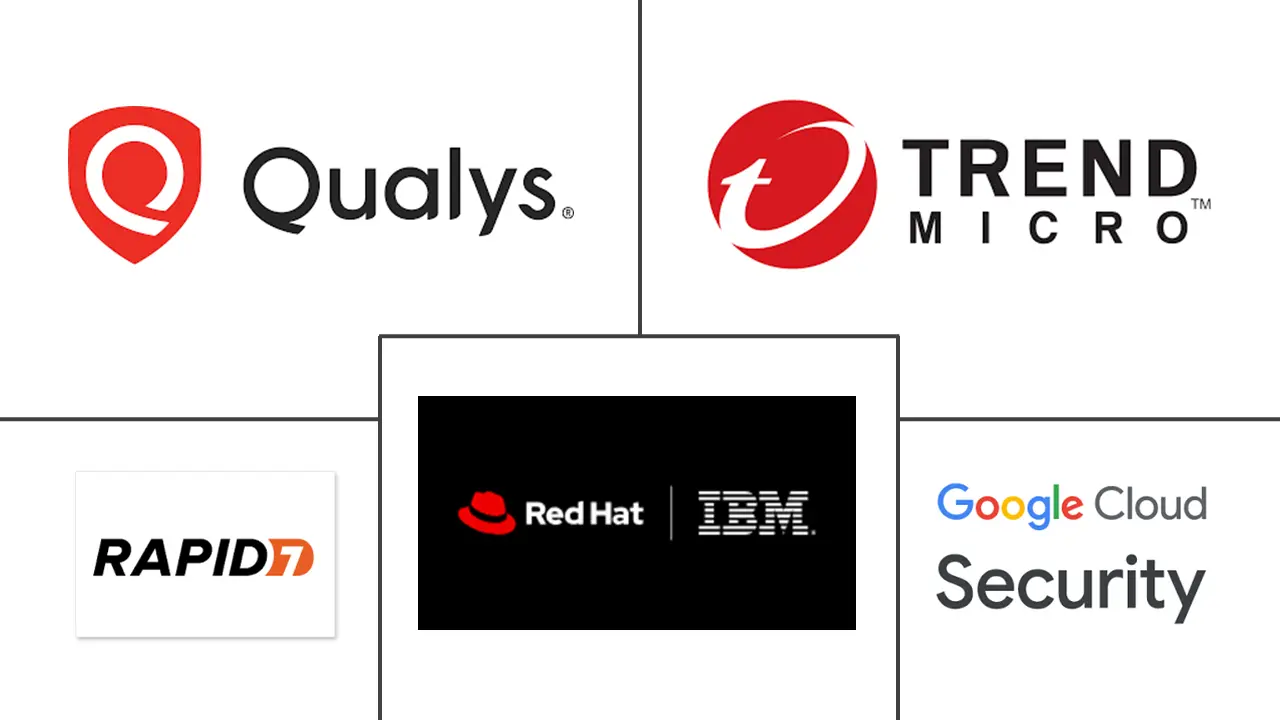Container Security Market Size and Share
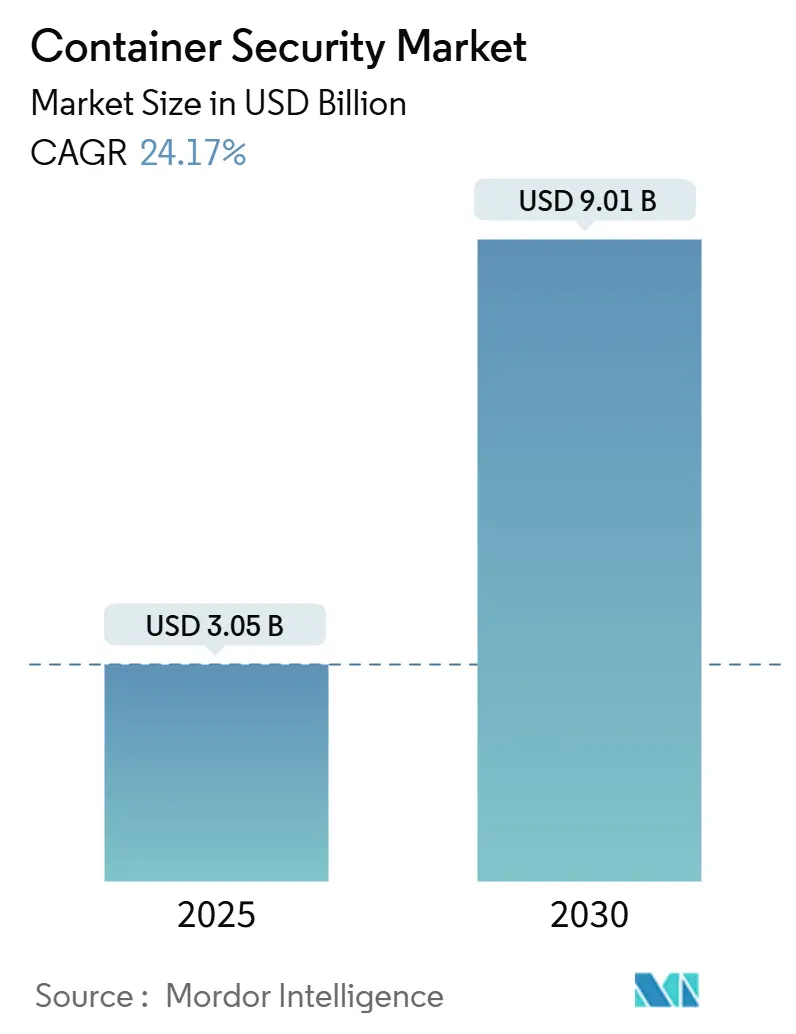
Container Security Market Analysis by Mordor Intelligence
The container security market size is estimated at USD 3.05 billion in 2025 and is projected to advance to USD 9.01 billion by 2030, registering a steep 24.17% CAGR. Unrelenting growth mirrors the migration from monolithic software to cloud-native, containerized architectures that sit across multiple clouds and edge sites . Organizations now favor zero-trust, workload-centric controls that travel with applications rather than traditional perimeter defenses. Demand further accelerates because 53% of Asia-Pacific enterprises already run containers in production and recognize that inconsistent security postures across clouds expose critical workloads . Heightened regulatory attention—covering PCI-DSS 4.0, NIS2 and software bill of materials (SBOM) disclosure—has turned container security from a discretionary investment into a compliance prerequisite cisco.com. In parallel, the rapid rollout of 5G and edge platforms introduces containerized network functions that create new attack surfaces and require specialized run-time safeguards redhat.com. Sustained venture funding and record-size acquisitions underscore the strategic role of cloud-native protection, exemplified by Google’s USD 32 billion purchase of Wiz in March 2025.
Key Report Takeaways
- By component, software accounted for 72.1% container security market share in 2024, while services are forecast to grow at a 24.7% CAGR through 2030.
- By organization size, large enterprises held 65.6% of the market in 2024; small and medium enterprises are expanding at 25.3% CAGR.
- By deployment, cloud-based models captured 56.8% share in 2024 and are growing at 26.2% CAGR.
- By security control, image scanning led with 32.5% share in 2024, whereas run-time protection is advancing at 25.7% CAGR.
- By end-user industry, IT and telecom commanded 27.1% revenue in 2024; healthcare is on track for the fastest 26.6% CAGR.
- By geography, North America dominated with 28.9% share in 2024, while Asia-Pacific is moving ahead at a 24.3% CAGR.
Global Container Security Market Trends and Insights
Drivers Impact Analysis
| Driver | (~)% Impact on CAGR Forecast | Geographic Relevance | Impact Timeline |
|---|---|---|---|
| Rising adoption of hybrid and multi-cloud container workloads | +4.20% | Global, with Asia-Pacific leading adoption | Medium term (2-4 years) |
| Rapid shift toward micro-services and DevSecOps pipelines | +3.80% | North America and EU, expanding to Asia-Pacific | Short term (≤ 2 years) |
| Mandatory security mandates (e.g., PCI-DSS 4.0, NIS2, SBOM) | +3.10% | EU-driven globally, US financial sector | Long term (≥ 4 years) |
| Rising frequency of supply-chain attacks on container images | +2.90% | Global, concentrated in developed markets | Short term (≤ 2 years) |
| Proliferation of edge and 5G container runtimes | +2.70% | Asia-Pacific core, spill-over to MEA | Medium term (2-4 years) |
| Hardware-level container isolation innovations | +1.80% | North America and EU technology hubs | Long term (≥ 4 years) |
| Source: Mordor Intelligence | |||
Rising adoption of hybrid and multi-cloud container workloads
Enterprises simultaneously operate workloads on two or more public clouds to optimize cost and resilience, yet inconsistent security controls, APIs and compliance obligations create visibility gaps that heighten risk. Financial institutions such as ABN AMRO centralize secrets with HashiCorp Vault across multiple clouds, demonstrating how platform-agnostic controls unify policies while preserving deployment choice. Security vendors now ship orchestration layers that discover every cluster, standardize policy and automate compliance evidence collection. Demand for unified dashboards and agentless discovery continues rising as multi-cloud complexity outweighs the benefits of isolated tools.
Rapid shift toward microservices and DevSecOps pipelines
Breaking large applications into hundreds of loosely coupled services improves release velocity but inserts security checks throughout continuous integration and continuous deployment flows. Forty-two percent of organizations reported advanced DevSecOps adoption in 2024, and another 48% were in early stages.[1]Red Hat, “Securing Hybrid-Cloud Container Workloads,” redhat.comRetailer Target deploys hundreds of updates weekly through its Unimatrix platform while embedding automated scanning and policy gates that prevent vulnerable images from reaching production. Security platforms increasingly expose native plugins for popular CI/CD tools, enable policy-as-code templates and auto-remediate misconfigurations before runtime.
Mandatory security mandates (PCI-DSS 4.0, NIS2, SBOM)
Regulators now codify container specific guidance. The European Union’s NIS2 covers 350,000 entities and references container orchestration hardening and supply-chain oversight.[2]European Parliament and Council, “Directive (EU) 2022/2555 (NIS 2),” europa.eu PCI-DSS 4.0 tightens requirements for payment workloads running inside Kubernetes, demanding least-privilege run-time controls and immutable image registries. Public-sector procurement rules require an SBOM, pushing enterprises toward automated bill-of-materials generation and attestation at build time.
Rising frequency of supply-chain attacks on container images
Attackers increasingly compromise registries and CI pipelines; researchers uncovered 8,000 exposed Kubernetes secrets, 203 with active registry credentials, affecting several Fortune 500 companies. Campaigns such as Dero miner exploit Docker APIs for covert cryptomining. The industry response centers on image signing, policy whitelists and real-time anomaly detection that flags drift from declared manifests. OWASP’s Kubernetes Top Ten formally lists image supply chain risk, amplifying industry focus.
Restraints Impact Analysis
| Restraint | (~)% Impact on CAGR Forecast | Geographic Relevance | Impact Timeline |
|---|---|---|---|
| Shortage of container-security skillsets in DevOps teams | -2.80% | Global, acute in emerging markets | Medium term (2-4 years) |
| Operational complexity of multi-cloud and multi-cluster estates | -2.10% | Enterprise-focused, North America and EU | Short term (≤ 2 years) |
| Alert-fatigue and false-positive overload | -1.60% | Global, affecting security operations centers | Short term (≤ 2 years) |
| Advanced container-escape kill-chains | -1.30% | High-security environments globally | Long term (≥ 4 years) |
| Source: Mordor Intelligence | |||
Shortage of container-security skillsets in DevOps teams
Demand for Kubernetes-savvy security engineers exceeds supply, particularly in emerging economies where universities have yet to roll out specialized curricula. Enterprises report longer deployment cycles as staff learning curves delay projects. Vendors now bundle prescriptive policy templates, AI chat assistants and managed detection services to narrow the expertise gap, but talent scarcity continues to dampen roll-out velocity.
Operational complexity of multi-cloud and multi-cluster estates
Maintaining consistent network segmentation, identity controls and audit evidence across scores of clusters often overwhelms security operations centers. Even seasoned teams must master each cloud provider’s API idiosyncrasies, which inflates integration budgets and invites configuration drift.[3]Microsoft, “Defender for Containers Technical Overview,” microsoft.com Cost overruns push risk-averse enterprises to limit deployments, slowing the container security market trajectory among conservative sectors.
Segment Analysis
By Component: Services Accelerate Platform Adoption
Software accounted for 72.1% of 2024 revenue, underscoring demand for automated scanning, policy engines and run-time detection built directly into orchestration layers. Professional and managed services, however, are growing at 24.7% CAGR because many enterprises need external specialists to design architectures, integrate pipelines and run 24/7 monitoring. Consulting engagements typically address secrets management, network micro-segmentation and compliance mapping across hybrid estates.
The services wave amplifies platform consumption as clients lean on expert partners to operate controls they cannot staff internally. Managed detection offerings covering Kubernetes, container registries and service meshes relieve resource-constrained teams, advancing broader penetration of the container security market. This trend also widens the addressable base among regulated industries that seek documented operational runbooks before committing production workloads.
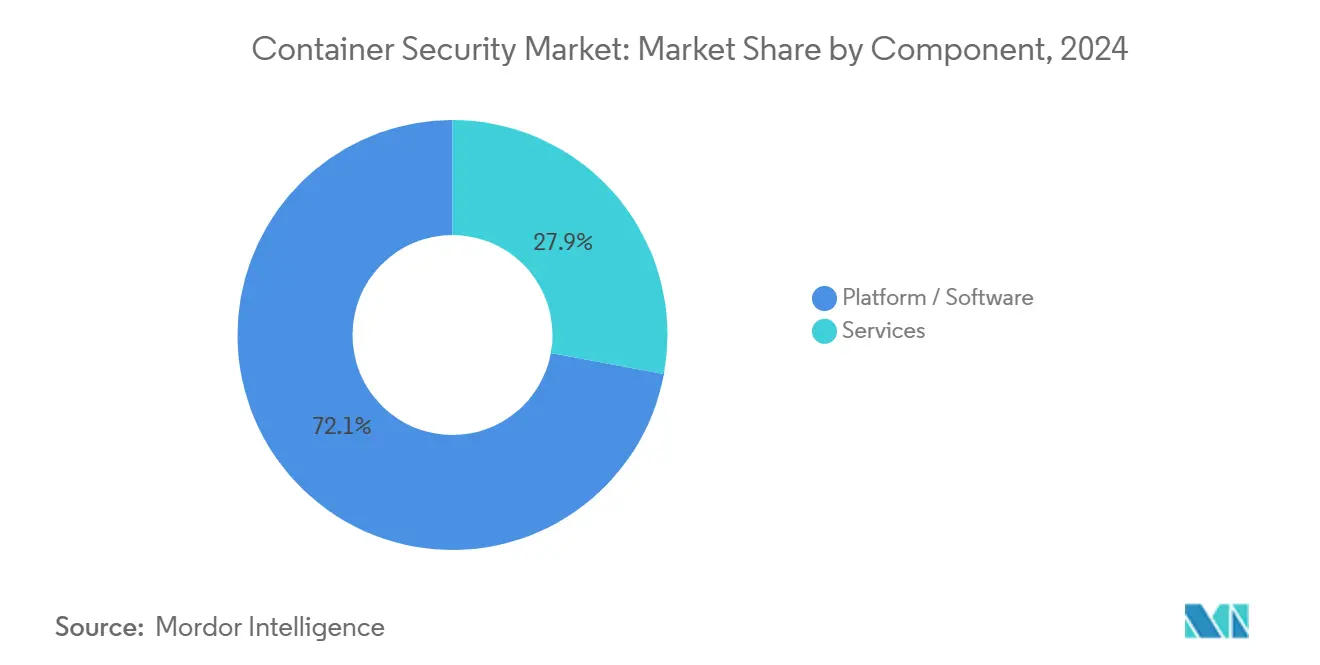
By Organization Size: SMEs Drive Democratization
Large enterprises retained 65.6% share in 2024 by virtue of sizable IT estates and regulatory obligations that demand full-stack protections. These customers embed policy-as-code, automated compliance evidence and deep packet inspection directly into microservice workflows, reflecting mature security postures.
Small and medium enterprises are expanding at 25.3% CAGR thanks to simplified, cloud-delivered offerings that mask complexity behind consumption-based pricing. Vendor bundles now bake scanning, secrets rotation and basic run-time guardrails into single dashboards, allowing SMEs to deploy containers without dedicated SOC staff. Solutions such as Kaspersky Container Security cater to distributed teams pursuing geographic expansion while maintaining governance, a dynamic that broadens container security market penetration among resource-constrained organizations.
By Deployment: Cloud-Native Security Transformation
Cloud-based deployments captured 56.8% share in 2024 and show a 26.2% CAGR through 2030 as organizations offload infrastructure management and tap native cloud telemetry. Microsoft Defender for Containers exemplifies the appeal: agentless vulnerability assessments, cross-cloud coverage and click-through compliance mapping reduce implementation overhead.
On-premise installations persist for sectors with strict data sovereignty rules, but hybrid architectures are gaining ground. Enterprises keep sensitive workloads on-site while centralizing policy orchestration in the cloud, ensuring consistent guardrails regardless of location. As hybrid tooling matures, the container security market size for cloud-hosted controls is projected to grow significantly faster than its on-premise counterpart through 2030.
By Security Control: Run-time Protection Gains Momentum
Image scanning and vulnerability management held 32.5% share in 2024, confirming that static analysis remains the first line of defense. Yet run-time protection and anomaly detection lead growth at 25.7% CAGR because threat actors increasingly target live containers with privilege-escalation and data-exfiltration techniques invisible to static scans. Vendors now layer eBPF-based behavioral analytics, process allow-lists and network flow inspection to catch malicious activity without injecting high overhead.
Policy-as-code frameworks enforce configuration baselines at build and deploy stages, while dynamic admission controllers block drift from golden manifests. These developments position run-time analytics as the next frontier in the container security market as enterprises recognize that pre-deployment hygiene alone is insufficient
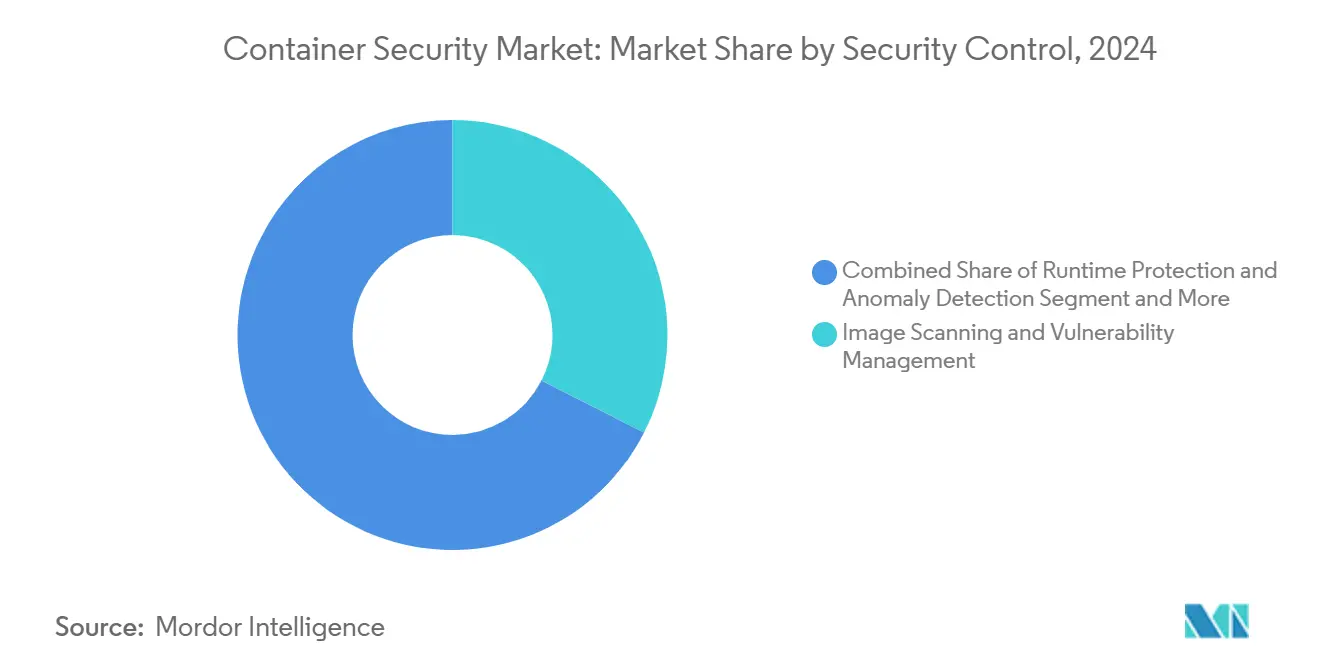
Note: Segment shares of all individual segments available upon report purchase
By End-user Industry: Healthcare Accelerates Digital Transformation
IT and telecom operators led demand with 27.1% of 2024 revenue, reflecting legacy telecom security expertise and early cloud-native adoption. Telcos use container security to safeguard virtualized network functions and edge nodes that underpin 5G services redhat.com.
Healthcare and life sciences, meanwhile, show the fastest 26.6% CAGR. Hospitals and research labs must protect electronic records, connected devices and AI diagnostic workloads while satisfying HIPAA and equivalent regimes. Automated SBOM generation, admission control and run-time anomaly detection address these compliance-intense environments, lifting the container security market size within healthcare throughout the forecast horizon.
Geography Analysis
North America commanded 28.9% revenue in 2024, benefiting from early Kubernetes adoption, high cyber-maturity and federal zero-trust directives. Landmark transactions such as Google’s acquisition of Wiz signal ongoing consolidation aimed at integrating container protection tightly into broader cloud platforms. Financial services, defense and technology verticals continue to shape features such as FIPS-compliant cryptography and multi-cluster federation.
Asia-Pacific is the fastest expanding region at a 24.3% CAGR. Digital initiatives, supportive government cloud policies and a swelling developer community place container rollouts on an accelerated curve, with 53% of regional firms already in production. Telecom operators leveraging 5G edge nodes and manufacturing firms adopting smart-factory blueprints are pivotal to regional growth. Rising cyber incidents also fuel spending on automated threat intelligence feeds and managed detection services.
Europe maintains significant share on the back of stringent data protection statutes. The NIS2 directive pushes roughly 350,000 organizations to uplift container orchestration defenses, elevating demand for governance-heavy controls and continuous compliance audits. Financial institutions rely on centralized secrets tools, such as HashiCorp Vault, to reconcile multi-cloud agility with privacy obligations. These dynamics assure steady container security market expansion across the continent.
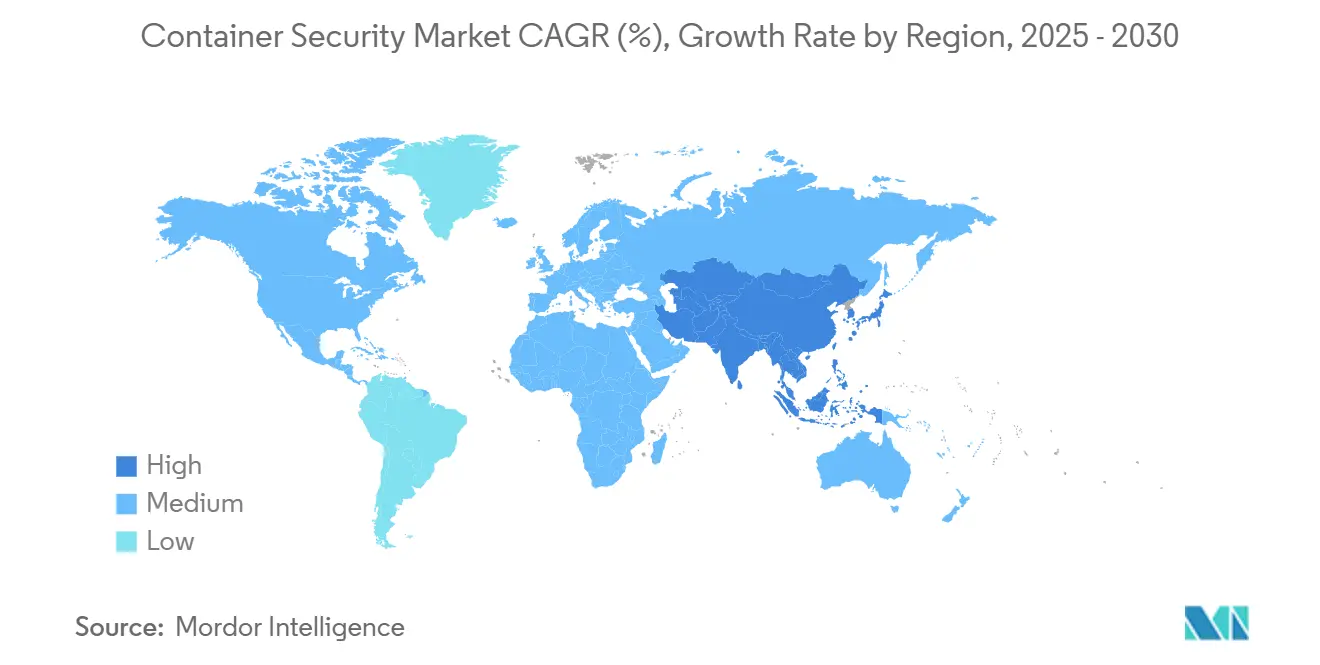
Competitive Landscape
The vendor field remains fragmented but is tilting toward consolidation as hyperscalers and cyber majors scoop up specialized players to assemble end-to-end cloud-native application protection platforms. Google’s USD 32 billion Wiz deal, Fortinet’s acquisition of Lacework and Palo Alto Networks’ agreement to purchase Protect AI illustrate the premium placed on container and AI workload security integration Newcomer Chainguard, valued at USD 3.5 billion after its April 2025 raise, challenges incumbents by distributing zero-CVE base images and focusing on developer ergonomics.
Product differentiation now hinges on cross-cloud coverage, agentless deployment, eBPF visibility and automated evidence gathering that shortcuts audit preparation. White-space remains around edge and 5G workloads where latency constraints require low-overhead enforcement. Patent activity, including Aqua Security’s grant for Dynamic Threat Analysis, underscores ongoing investment in behavioral analytics that adapt in real time to evolving kill chains.
Vendor alliances are equally active. Snyk and Orca combine developer-first scanning with cloud-wide posture management, while Harness and Traceable integrate AI code insights with API defense to shorten feedback loops. These moves ensure that the container security market progresses toward converged platforms where build-time, deploy-time and run-time controls operate within one policy plane.
Container Security Industry Leaders
-
Google Cloud Security
-
Red Hat (IBM)
-
Trend Micro
-
Qualys
-
Rapid7
- *Disclaimer: Major Players sorted in no particular order
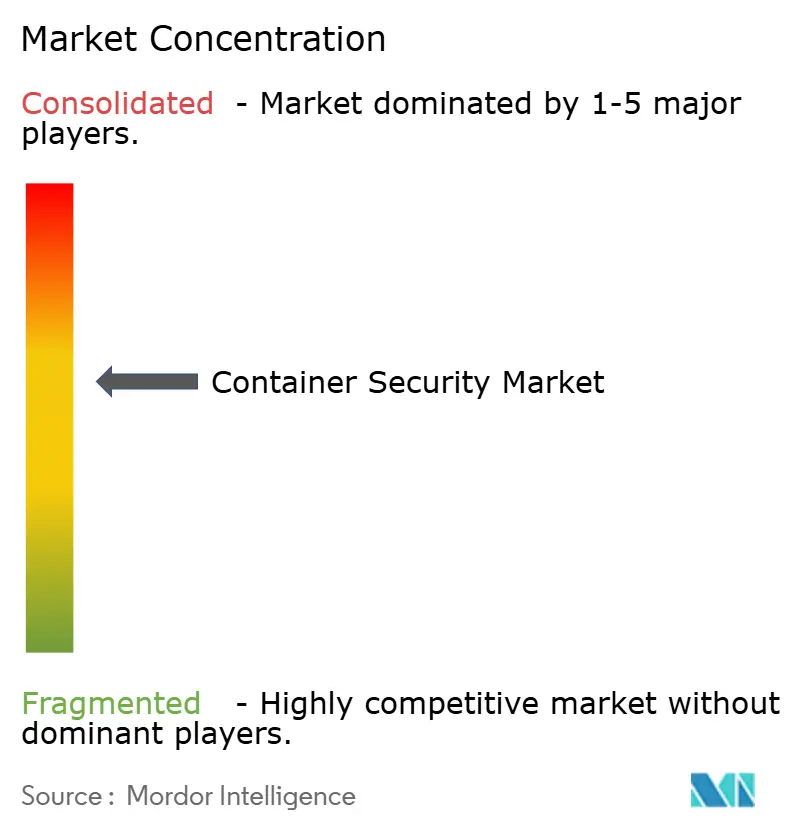
Recent Industry Developments
- June 2025: Chainguard and Azul partnered to deliver hardened, zero-CVE Java container images for enterprise environments.
- May 2025: Red Hat released OpenShift Lightspeed, a generative-AI assistant that reduces skills gaps through natural-language security queries.
- April 2025: Palo Alto Networks announced intent to buy Protect AI for up to USD 700 million, expanding coverage of AI/ML supply-chain vulnerabilities.
- April 2025: Chainguard closed a USD 356 million Series D financing round at a USD 3.5 billion valuation, underscoring investor confidence in supply-chain protection.
Research Methodology Framework and Report Scope
Market Definitions and Key Coverage
Our study defines the container security market as revenues earned from software platforms and associated support services that scan container images, enforce runtime protection, manage vulnerabilities, and assure policy compliance across Kubernetes, Docker, and other containerized workloads that run in public cloud, private cloud, or on-premise clusters. According to Mordor Intelligence analysts, the frame of reference is end-user spend, not vendor bookings or device counts.
Scope Exclusions: Host operating-system hardening tools and firewalls that do not expose container-level telemetry are outside the modeled market.
Segmentation Overview
- By Component
- Platform / Software
- Services
- By Organisation Size
- Large Enterprises
- Small and Medium Enterprises
- By Deployment
- Cloud-based
- On-premise
- By Security Control
- Image Scanning and Vulnerability Management
- Runtime Protection and Anomaly Detection
- Compliance and Configuration Management
- By End-user Industry
- IT and Telecom
- BFSI
- Retail and e-Commerce
- Healthcare and Life Sciences
- Industrial and Manufacturing
- Others (Media, Education, Gov.)
- By Geography
- North America
- United States
- Canada
- Mexico
- South America
- Brazil
- Argentina
- Rest of South America
- Europe
- Germany
- United Kingdom
- France
- Italy
- Spain
- Rest of Europe
- Asia-Pacific
- China
- Japan
- India
- South Korea
- Australia
- Rest of Asia-Pacific
- Middle East and Africa
- Middle East
- Saudi Arabia
- United Arab Emirates
- Turkey
- Rest of Middle East
- Africa
- South Africa
- Nigeria
- Egypt
- Rest of Africa
- Middle East
- North America
Detailed Research Methodology and Data Validation
Primary Research
Mordor analysts interviewed CISOs, DevSecOps architects, and managed security service providers across North America, Europe, and Asia-Pacific. Dialogue centered on protection budgets per container host, expected shift from image scanning to runtime defense, and typical refresh cadences. Responses validated secondary assumptions and clarified regional discount structures that desk work alone cannot surface.
Desk Research
We collated baseline signals from open datasets such as NIST's National Vulnerability Database, CNCF's annual Cloud Native survey, shipment trends in IDC's cloud system tracker, and regional cloud-spend statistics from the International Telecommunication Union. Company 10-Ks, investor decks, and security advisories were screened to benchmark average selling prices and adoption cycles. Premium feeds from Dow Jones Factiva and D&B Hoovers added context on funding rounds and M&A that affect vendor capacity. These sources illustrate, not exhaust, the literature reviewed; many additional publications informed data cleaning, cross-checks, and gap filling.
Market-Sizing & Forecasting
A top-down construct begins with the global container workload pool that is rebuilt from hyperscale usage statistics and CI/CD pipeline volumes, which are then multiplied by verified security spend per workload tier to derive the baseline value. Supplier roll-ups, sampled platform pricing, and channel checks supply bottom-up guardrails that reconcile the total within a specified band. Key model drivers include: (1) percentage of cloud workloads deployed in containers, (2) mean container image pulls per month, (3) published CVE growth rate, (4) compliance audit frequency in regulated sectors, and (5) regional cloud capital expenditure. A multivariate regression, supplemented by scenario analysis for aggressive and conservative adoption paths, projects revenue through the forecast period; anomalies trigger re-runs before values are locked.
Data Validation & Update Cycle
Outputs pass three layers of analyst review, variance checks against disclosed vendor earnings, and statistical outlier tests. We refresh every twelve months, with interim updates when sizable funding rounds, zero-day exploits, or regulatory mandates materially sway assumptions.
Why Mordor's Container Security Baseline Is Dependable
Published figures often diverge because firms apply different workload counts, bundle adjacent segments, or update less frequently. By centering on end-user spend and balancing macro indicators with frontline price discovery, Mordor delivers a traceable, balanced anchor.
Benchmark comparison
| Market Size | Anonymized source | Primary gap driver |
|---|---|---|
| USD 3.05 B (2025) | Mordor Intelligence | - |
| USD 2.35 B (2024) | Global Consultancy A | Excludes professional services and uses older currency rates |
| USD 2.43 B (2024) | Industry Research Firm B | Bundles Kubernetes platform licensing, limited primary validation |
| USD 2.40 B (2024) | Digital Insights Journal C | Relies on vendor surveys only and omits Asia-Pacific spend |
The comparison shows that scope breadth, refresh cadence, and source diversity drive the observable gaps. Mordor's disciplined blend of public signals and practitioner insight therefore provides the most reliable starting point for strategic decisions.
Key Questions Answered in the Report
What is the current value of the container security market?
The container security market size stands at USD 3.05 billion in 2025 and is projected to reach USD 9.01 billion by 2030.
Which component leads the container security market in 2024?
Software solutions lead with 72.1% container security market share in 2024, although services are growing faster at a 24.7% CAGR.
Why is Asia-Pacific the fastest growing region?
Aggressive digital transformation, 5G deployments and 53% production-level container adoption propel the region at a 24.3% CAGR.
Which security control segment is expanding most rapidly?
Run-time protection and anomaly detection solutions are advancing at 25.7% CAGR as enterprises recognize threats that emerge after deployment.
Page last updated on:
